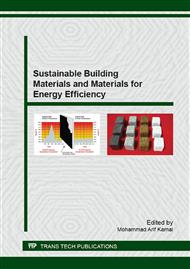p.38
p.51
p.71
p.82
p.91
p.105
p.114
p.122
p.131
Physico-Mechanical Properties of Banana Fiber Reinforced Polymer Composite as an Alternative Building Material
Abstract:
Utilization of natural fiber as reinforcing material is the latest trend in polymer science to produce higher strength with lower weight composite materials having wide range of applications. As a natural fiber, banana fiber is getting importance in recent years in the reinforcement arena of polymer composite. Two species of banana viz Musa sapientum and Musa paradisica available in North East India were selected considering their higher fiber yield and adequate strength properties of the fibers. The chemical compositions, spectroscopic and thermal properties of these fibers were studied in order to study their suitability for commercial exploration. Low density polyethylene (LDPE)-banana fiber reinforced composites were prepared using hydraulic hot press. Physico-mechanical properties (e.g. tensile strength, flexural strength, elongation at break, Young's modulus) of the prepared composites were determined. The tensile strengths and flexural strengths of the composites increased while using LDPE 10 to 30 % of the fiber and then started to decrease gradually. Young moduli of the composites increased with the increase of fiber mass. Water absorption also increased accordingly with the increase of the fiber weight. The elongation at break decreased with increasing fiber quantity. The mechanical strength properties of chemically treated banana fiber-LDPE composites were slightly higher than the mechanically extracted fiber-LDPE composites. Structural analyses of the treated fibers were carried out by FTIR and XRD. These studied revealed due to the removal of noncellulosic constituents such as hemicelluloses and lignin the crystalline properties of the fibers were increased. All the properties of composite like tensile strength, flexural strength, water absorption capacity etc. plays a significant role in these polymer composite materials. Hence it can be concluded that banana fiber can be used as reinforced agent successfully in the composite industry as a sustainable building material.
Info:
Periodical:
Pages:
131-138
Citation:
Online since:
July 2015
Authors:
Keywords:
Price:
Сopyright:
© 2015 Trans Tech Publications Ltd. All Rights Reserved
Share:
Citation:


